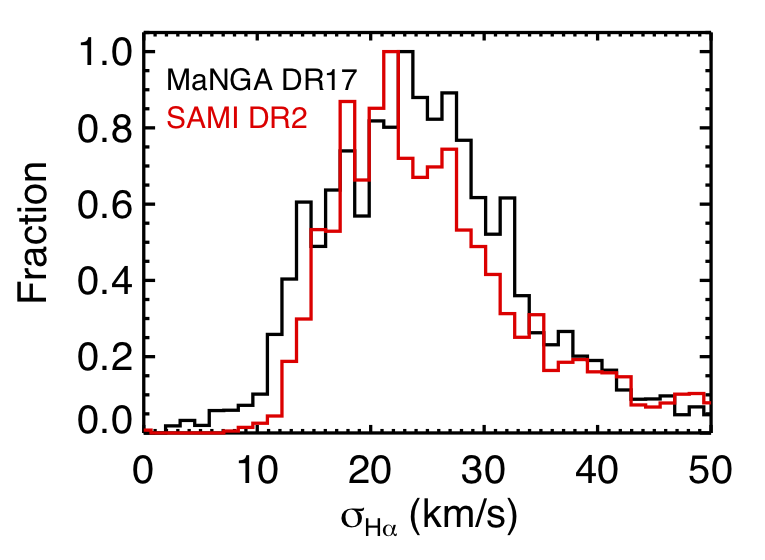What’s New in DR17
DR17 is the final MaNGA data release, and contains all raw data and science data products from the survey. In addition, both the Data Reduction Pipeline (DRP; v3_1_1) and Data Analysis Pipeline (DAP; 3.1.0) have been updated to improve the quality of the MaNGA data products compared to DR15 (DR16 contained no new MaNGA data products). Significant changes since DR15 are summarized below.
Additionally, Law et al. 2021 provides an overview of all DRP changes since the original technical description of Law et al. 2016 and a brief summary of some DAP changes; see also the software change logs listed below.
Change Logs
We maintain detailed change logs for all of our software products. Locations of detailed change logs are found at the following locations.
| Data Reduction Pipeline (DRP) | RELEASE_NOTES | |
| Data Analysis Pipeline (DAP) | CHANGES.md | ReadTheDocs |
| Marvin | CHANGELOG | ReadTheDocs |
Updated DRPall format
Spectral Line-Spread Function
As discussed in detail by Law et al. 2021, in DR17 the pipeline-estimated LSF has been improved to sub-percent accuracy based on comparison against data from spectrographs with substantially higher spectral resolution. At high astrophysical velocity dispersions (i.e., greater than the ~ 70 km/s instrumental line width) the impact of these updated LSF estimates will be minimal. At low astrophysical velocity dispersions however the values recovered by the DAP (which subtracts the instrumental LSF from the measured signal in quadrature) have changed significantly and are now robust down to 20 km/s or below for sufficiently high SNR emission lines. Any analyses of the cold gas velocity dispersion for instance should thus use DR17 data instead of DR15 or earlier results.

The various data models for intermediate and final-stage DRP data products have been changed accordingly to introduce new extensions and/or modify the names of existing LSF-related extensions accordingly (e.g., changing the DISP and PREDISP extension names to the more descriptive LSFPRE and LSFPOST for the pre-pixellized and post-pixellized LSF estimates). See the MaNGA Data Model for further details.
Updated Flux Calibration
As the MaNGA sample size has built up over the course of the survey, it has become possible to self-calibrate the metrology using on-sky observations compared to previous SDSS broadband imaging. This exercise revealed a ~ 2.5% systematic error in the overall scale factor of the original laboratory-based metrology. After correcting for this factor in the MaNGA reference metadata the overall flux normalization of the survey data increased by about 3% due to the changed aperture loss correction factor for the calibration minibundles. See Law et al. 2021 (their Appendix A) for details.
New Data Quality Flags
These 'blowtorch' cases result from a severe electronic artifact on one of the BOSS cameras during the final year of survey operations which required a significant revision to the DRP to satisfactorily process the data. See Law et al. 2021 (their Appendix B) for details.
In total, of the 11,273 data cubes in MPL-11 there are 69 flagged with the UNUSUAL data quality bit and 86 flagged with the CRITICAL data quality bit.
Number of Galaxies
drpall=mrdfits('drpall-v3_1_1.fits',1)
galaxies=drpall[where(((drpall.mngtarg1 ne 0)or(drpall.mngtarg3 ne 0)) $
and((drpall.mngtarg3 and 2L^19L+2L^20L+2L^21L+2L^27L) eq 0))]
we are left with 10,296 data cubes. Not all of these have the highest data quality though for a variety of observational reasons. If we restrict ourselves only to those data cubes that do not have either the UNUSUAL or CRITICAL MANGA_DRP3QUAL quality flags set (bits 14 and 30 respectively):
highqual=galaxies[where((galaxies.drp3qual and 2L^14L+2L^30L) eq 0)]
we are left with 10,145 data cubes. Not all of these are unique galaxies though as some galaxies were observed multiple times. If we use the MANGAID galaxy identifier to weed out only unique galaxies:
mangaid=highqual.mangaid uniquegals=highqual[uniq(mangaid,sort(mangaid))]
we are left with a sample of 10,010 unique, high-quality galaxy data cubes. Note, however, that there is still some potential confusion that can arise from treatment of merging galaxy pairs; see Caveats for details.
DAP Continuum Templates
- Age [Gyr]: 0.00316228, 0.01, 0.03162278, 0.100, 0.300, 1.000, 3.000, 9.000, 14.000
- log(Z/Zsun): -1.35, -1., -0.7, -0.33, 0, 0.35
- IMF Slope: 2.35 (Salpeter)
We also performed a clustering analysis of MaStar spectra to construct a set of composite stellar templates, which we refer to as the MASTARHC2 library. These templates are only provided for a single binning type in DR17. See additional discussion here.
Comparisons between the emission-line results based on the MASTARSSP and MASTARHC2 libraries can be used to assess systematic errors due to the chosen template library (cf. Law et al. (2021, in press).
DAP Data Model Changes
- an expanded set of emission lines with measured properties,
- a new approach to our spectral index measurements,
- a better organized set of model spectra,
and many other improvements. See the updated MaNGA DAP Data Model and ReadTheDocs for details.


